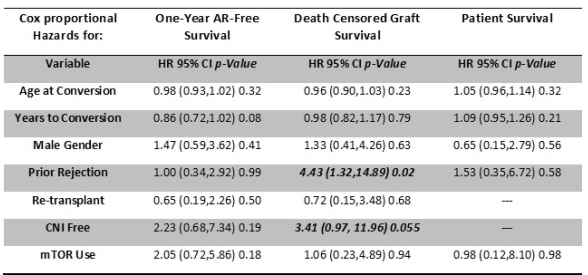Outcomes of Enteric Conversion of Bladder Drained Pancreas; over a Decade of Experience at a Single Center
1U of MN, Minneapolis
2Fairview, Minneapolis
3U of MN, Minneapolis.
Meeting: 2018 American Transplant Congress
Abstract number: A334
Keywords: Pancreas transplantation
Session Information
Session Name: Poster Session A: Pancreas and Islet: All Topics
Session Type: Poster Session
Date: Saturday, June 2, 2018
Session Time: 5:30pm-7:30pm
 Presentation Time: 5:30pm-7:30pm
Presentation Time: 5:30pm-7:30pm
Location: Hall 4EF
Background: Bladder drainage in pancreas transplantation has been used to enable early detection of rejection. This technique has declined due to concern over complications necessitating enteric conversion (EC). We sought to study the outcome of EC and its impact on the pancreas graft and kidney function.
Methods: We analyzed 177 pancreas transplants (PTA 138, PAK 10 and SPK 39) who underwent EC between 2003 and 2016. Kaplan-Meier curves and Cox proportional hazards models (CPHM) were used to assess rates of acute rejection-free survival (ARFS), death-censored graft survival (DCGS) and patient survival (PS) within one year of conversion, and the predictors of these outcomes respectively. A paired t-test was used to compare the change in creatinine before and after conversion for non-dialysis recipients.
Results: The probabilities of ARFS, DCGS and PS were 87.7%, 92.4% and 95.4% at one year respectively.  In the CPHM, acute rejection prior to conversion was associated with a more than four-fold increase in the risk of death-censored graft loss- HR 4.43 (95% CI 1.32, 14.89), p 0.02. CNI-Free maintenance showed a trend toward increased risk of death-censored graft loss – HR 3.41 (0.97, 11.96) p 0.055. The mean creatinine after conversion remained stable although statistically decreased -0.08 mg/dL (95% CI -0.16, -0.01) p 0.036. No independent predictors of survival or acute rejection were identified; it should be noted that a reduced model was used for survival due to a relative lack of events.
In the CPHM, acute rejection prior to conversion was associated with a more than four-fold increase in the risk of death-censored graft loss- HR 4.43 (95% CI 1.32, 14.89), p 0.02. CNI-Free maintenance showed a trend toward increased risk of death-censored graft loss – HR 3.41 (0.97, 11.96) p 0.055. The mean creatinine after conversion remained stable although statistically decreased -0.08 mg/dL (95% CI -0.16, -0.01) p 0.036. No independent predictors of survival or acute rejection were identified; it should be noted that a reduced model was used for survival due to a relative lack of events. 
Conclusion: Enteric conversion of the bladder-drained pancreas is a relatively safe procedure and well tolerated. Kidney function remained clinically stable after EC. History of prior rejection was associated with increased risk of graft loss.
CITATION INFORMATION: Riad S., Keys D., Vakil V., Jackson S., Berglund D., Matas A., Kandaswamy R. Outcomes of Enteric Conversion of Bladder Drained Pancreas; over a Decade of Experience at a Single Center Am J Transplant. 2017;17 (suppl 3).
To cite this abstract in AMA style:
Riad S, Keys D, Vakil V, Jackson S, Berglund D, Matas A, Kandaswamy R. Outcomes of Enteric Conversion of Bladder Drained Pancreas; over a Decade of Experience at a Single Center [abstract]. https://atcmeetingabstracts.com/abstract/outcomes-of-enteric-conversion-of-bladder-drained-pancreas-over-a-decade-of-experience-at-a-single-center/. Accessed July 18, 2025.« Back to 2018 American Transplant Congress
